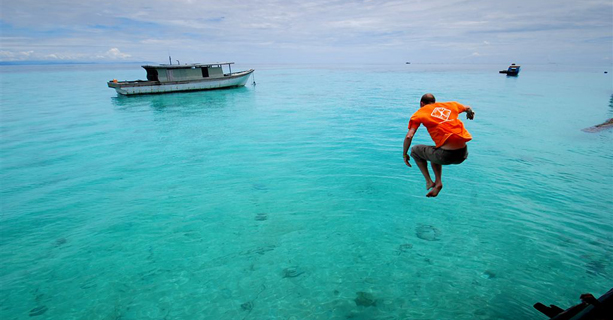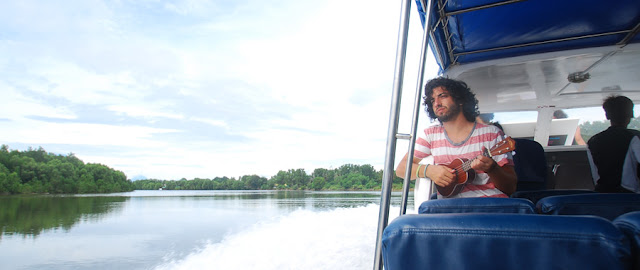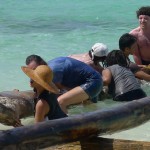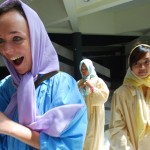Arkitrek Camp – Mantanani Island 2011 (Part 2)
Arkitrek Camp – Blog series by Richard Nelson Sokial (Part 2 of 5)
Original post can be found at the Sabah Architectural Heritage Blog
It was barely daybreak when the bus came to pick us up from Kipouvo village. I followed Ian into KK city to tie up a few loose ends before joining the others as we took to the road in the direction of Kuala Abai, where a speedboat was awaiting our arrival.

We were joined by Melanie Chu, General Manager at Camp Borneo. Also on the trip was Aida Rahman, the rasta-haired Camp Manager for Camp Mantanani (under Camp Borneo).
The journey to Mantanani took approximately 45 minutes by speedboat – passing through scenic mangrove tributaries and a village at the rivermouth, before heading out to the open sea.
I noticed that Aida, Melanie and Daniele had all brought along what seemed like miniature toy guitars on this trip. As it turns out, these ‘toy guitars’ were actually Ukeleles. Aida says that Ukeleles are becoming a ‘thing’ on Mantanani.
Of course, my imagination went into overdrive…
A sliver of deep blue clusters soon appeared on the ocean horizon, giving us our first glimpse of Mantanani island. Soon, we reached the shallows of the beach – where everyone gasped in collective awe at the sight of the island’s raw beauty.
“OMG, look at the water!”
The amazing crystal-clear quality of Mantanani’s seawater, waist deep over a white sandy seabed captivated all of us newcomers to the island. My first instinct was to just jump in; alas I remembered that my handphone did not swim very well.
Camp Mantanani’s staff were on hand to help us off the boat and took our supplies onto shore.
We were introduced to Albi and his family, who help to run Camp Mantanani when youth groups visit the island for Camp Borneo’s activities. Albi is also the headman of the village where Camp Mantanani and the Arkitrek Camp’s project site are situated.
Aida and Albi took us to visit his village.
According to Aida, the island is inhabited by fishermen from the Ubian ethnic group, with a population of approximately 800 people. The Mantanani islanders make some minimal wages drying salted fish and selling it to the mainland towns in Kota Belud.
That’s a lotta dried fish.
Albi doing his village headman pose in front of the school.
Aida and Mel saying ‘Helloo’ to the locals.
Just me in a Mantanani boat house, being awesome.
The crystal-clear water proved too much to resist…
…jump!
…Woo hoo!
…marvellous!
It was bound to happen at some point. Haha.
After throwing ourselves off Albi’s village jetty, we went back to camp for Mel and Aida’s briefing in regards to what they wanted the Arkitrek Camp participants to build. Camp Mantanani hoped to establish a marine conservation centre on the island to facilitate not only the activities of future camp participants but also a learning centre-cum-kid’s playground for the island community.
Our site was a kid’s playpen-with-tower known as ‘The Magellan’ that was built by past Camp Borneo participants.
Mel and Aida gave us an open-ended brief to re-use the structure or tear it down for the new building. We opted for the latter.
On the top left, is the sandy path that links the two villages on Mantanani island.
We were sad to learn from Aida that the rare and friendly Dugongs that once frequented the island to graze on the sea grass had now disappeared, most likely because of the fish bombing activities that are still prevalent in the waters around Mantanani.
Aida also explained several other key challenges affecting the social and economic status of the island people.
Rubbish washed up on the beaches of Mantanani is also an ongoing problem. Some of it is thrown away by the island’s inhabitants. Some floating debris finds its way to Mantanani’s beaches from the mainland, while other floating garbage is carried by sea currents from other places to the island.
We even found a plastic bottle from Thailand. Imagine that.
Camp Mantanani hopes to establish a place to promote marine conservation awareness amongst the Mantanani villagers so that they can provide better stewardship for the island for years to come.
As participants and volunteers, we realised that our project – if we succeeded – would be a catalyst for the aspirations of Camp Mantanani. It would empower the villagers of Mantanani to take ownership of their environment and to manage it sustainably, making use of materials that they never thought could be used for buildings.
As a group of young architects and designers, Mel threw us the gauntlet: To design an architecturally iconic learning centre and playground for the village children and visitors to Mantanani, using driftwood and other suitable materials salvaged from the beaches of Mantanani.
Were the arkitrekkers up for the challenge?
Related posts



























